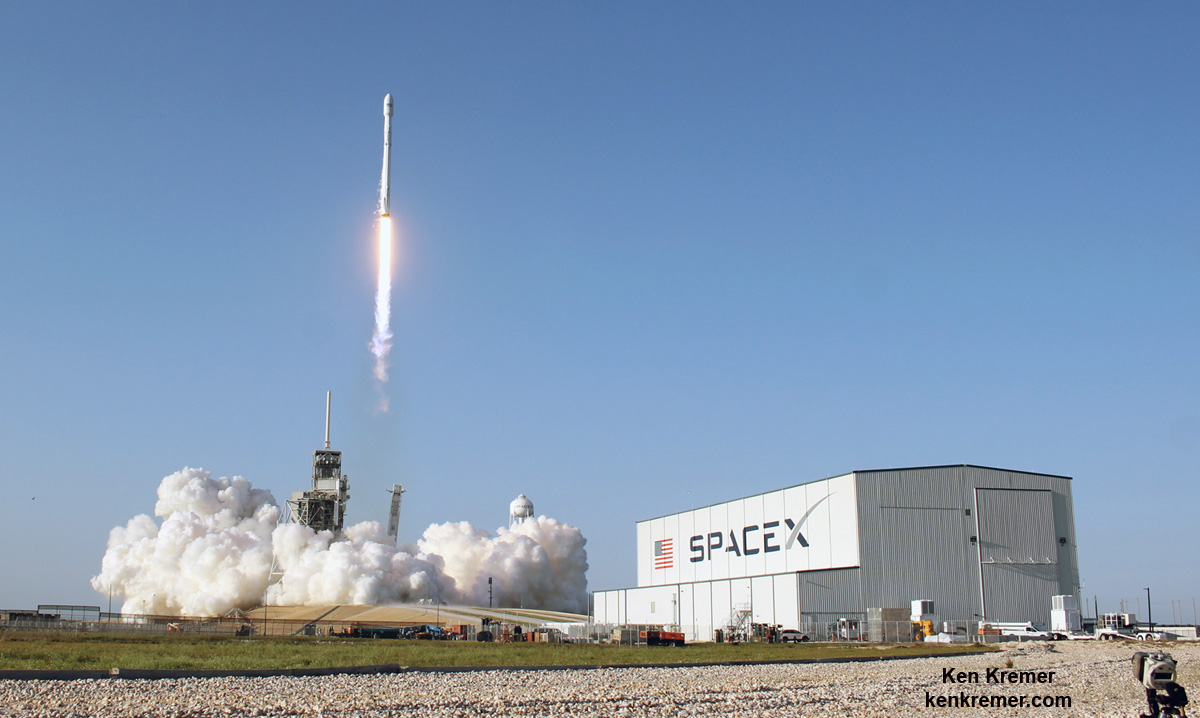
An official weather outlook issued by U.S. Air Force meteorologists Thursday calls for partly cloudy skies on Florida’s Space Coast for liftoff of a SpaceX Falcon 9 rocket just after sunrise Sunday with a clandestine payload for the U.S. government’s intelligence agencies.
Forecasters predict the only concerns at launch time Sunday will be liftoff winds and cumulus clouds associated with isolated rain showers around launch pad 39A at NASA’s Kennedy Space Center. There is an 80 percent chance of acceptable conditions.
The launch period opens at 7 a.m. EDT (1100 GMT) and extends for two hours. SpaceX and the National Reconnaissance Office, which owns the top secret payload launching on the Falcon 9 rocket, have not announced when the launch will occur during the two-hour window.
The Air Force’s 45th Weather Squadron said Thursday that partly cloudy skies, isolated rain showers and gusty winds are expected Sunday morning. The temperature at launch time should be around 74 degrees Fahrenheit, and winds will be from the southeast at 20 to 25 mph.
Sunday’s launch will be the 33rd flight of a Falcon 9 rocket, and SpaceX’s fifth launch of the year. It will be SpaceX’s first flight since launching a previously-used Falcon 9 booster with an SES commercial communications satellite March 30.
But this weekend’s mission, designated NROL-76, will fly on an all-new launcher. U.S. government customers, including the NRO, the Air Force and NASA, are still certifying reused rockets to haul up their expensive spacecraft.
The NRO has not disclosed the identity or purpose of the payload launching Sunday. The spy agency is part of the U.S. government’s intelligence community and rarely reveals information about its missions, which typically fly on top of United Launch Alliance Atlas 5 and Delta 4 rockets.
The orbital deployment will be SpaceX’s first launch dedicated to the NRO. Two NRO-sponsored CubeSats launched piggyback on a Falcon 9 rocket with the first test flight of SpaceX’s Dragon cargo craft in December 2010.
The surveillance agency tapped SpaceX for the NROL-76 mission some time in 2012 or 2013 before the company’s Falcon 9 rocket was eligible to compete for national security launch contracts. The launch deal was reportedly a sole-source contract awarded to SpaceX without a competition.
Hazard notices released in the last few days indicate the rocket will head northeast from Cape Canaveral bound for a high-inclination orbit that flies over most of the planet’s population. The Falcon 9’s second stage will conduct a de-orbit burn after deploying its top secret passenger, aiming for a destructive re-entry over the South Indian Ocean southeast of Madagascar, according to warnings issued to pilots.
Despite the hints, the exact orbit targeted on Sunday’s mission remains secret.
Analysts suspect the mission may carry a communications relay craft into a high-altitude egg-shaped Molniya orbit that stretches as high as 25,000 miles (40,000 kilometers) above Earth. Part of the NRO’s so-called Satellite Data System fleet flies in Molniya orbits, which can loiter for several hours a day over the North and South Pole, to pass imagery and reconnaissance data from low-altitude spacecraft to ground stations, routing the information to intelligence officials faster than if the network relied solely on ground-based antennas.
The last NRO relay satellite launched into a Molniya orbit took off in 2007.
Ted Molczan, a respected tracker of satellite movements, believes the payload aboard Sunday’s launch is either a relay station heading for a Molniya-type orbit or another kind of satellite — perhaps an experimental mission — going into a lower orbit with an altitude of several hundred miles.
One clue about the payload is SpaceX’s plan to recover the Falcon 9 first stage at Cape Canaveral, a maneuver that requires significant leftover fuel and is only possible on missions with lightweight satellites or launches into relatively low orbits.

Heavier payloads going into higher orbits restrict SpaceX to attempting rocket landings on a barge positioned in the ocean downrange from the launch site, and the most demanding satellite missions require all of the propellant reserve on the current version of SpaceX’s Falcon 9 rocket, eliminating any possibility of a landing.
Some satellite-watchers see a parallel with an experimental NRO satellite that launched in December 2006 into a 225-mile-high orbit atop a Delta 2 rocket from Vandenberg Air Force Base in California. That demonstration craft failed soon after arriving in its high-inclination orbit, which took it between 58.5 degrees north and south latitude during each trip around Earth.
The U.S. military launched a missile in February 2008 to intercept the stricken satellite before it could re-enter the atmosphere, citing an imperative to destroy the spacecraft before it could fall uncontrolled back to Earth with a full tank of frozen toxic fuel on-board.
Molczan believes the NROL-76 payload could be a follow-on experimental mission similar to the failed satellite launched in 2006, but he thinks the Molniya orbit destination is a more likely explanation from the little information publicly available.
While it is easy to rule out the payload launching Sunday as a geostationary eavesdropping satellite or a polar-orbiting spy camera, there is no way to tell whether the spacecraft is going to a high or low orbit, according to Jonathan McDowell, an astronomer at the Harvard-Smithsonian Center for Astrophysics who monitors global spaceflight activity.
There is also a possibility that the rocket will carry a new type of NRO mission, and a global group of skywatchers will attempt to locate the satellite soon after Sunday’s liftoff in hopes of narrowing down its identity.
Betty Sapp, director of the NRO, said April 4 that the agency is developing new capabilities to enhance the spy satellite fleet. One aspect of that drive is “adapting and adopting commercially available products and capabilities into our mission set,” she said in a speech at the 33rd Space Symposium in Colorado Springs.

“We are still the nation’s eyes and ears in space, and doing that job today is much more difficult that it was even back in the Cold War, despite the march in technology,” Sapp said. “We support a much more diverse mission set. We’re still keeping an eye on weapons of mass destruction and major weapons developments, but those aren’t confined anymore to just one country.
“We’re still supporting U.S. policymakers, but we’re also supporting — very directly — U.S. warfighters, and we’re helping to protect U.S. borders, and of course, we’re very much in the fight against ISIS,” Sapp said.
Molczan believes the satellite launching Sunday might be linked to a U.S. government order of three Boeing-built satellites with all-electric propulsion in early 2013. None of the satellites from the purchase, disclosed in March 2014, are believed to have launched to date.
Four commercial all-electric satellites based on the Boeing 702SP design have launched in pairs on two SpaceX Falcon 9 rockets, heading to geostationary orbit on telecom missions for Eutelsat and Asia Broadcast Satellite. Another commercial all-electric Boeing 702SP spacecraft for the commercial operator SES is set for a solo launch in May on a Russian Soyuz rocket from French Guiana.
The Boeing 702SP bus relies on more efficient electric thrusters for all maneuvers after launch, instead of carrying a larger tank of conventional chemical rocket propellant. The switch reduces the weight of the satellite at launch, allowing it to fly on a smaller, less expensive booster without sacrificing the spacecraft’s capabilities.
“I am warming to the Molniya SDS (Satellite Data System) idea, mainly because Falcon 9 … appears to have sufficient performance to directly inject a single (Boeing) 702SP spacecraft into nearly the final Molniya orbit, leaving the payload with a nearly complete fuel supply at the outset of its mission, available to compensate for the large perturbations experienced by Molniya orbits,” Molczan wrote in an online forum for amateur satellite trackers.
The only way to know for sure is for trackers to find the satellite and plot its orbit following Sunday’s launch.
Quelle: SN
---
Update: 29.04.2017
.
SpaceX launch of government satellite slated for Sunday morning
SpaceX will be sending another Falcon 9 rocket up from Kennedy Space Center Sunday morning, launching a spy satellite for the U.S. Department of Defense.
The two-hour window to launch the classified National Reconnaissance Office satellite known as NROL-76 opens at 7 a.m. This will be the fourth launch by the private Hawthorne, California-based company from Launch Pad 39A at the space center.
Once again, SpaceX will attempt to safely land its first-stage booster, this time on land at Cape Canaveral Air Force Station.
The launch of the government spy satellite marks the first time the Department of Defense has used SpaceX for a mission.
For at least the last six years, that arena has been the exclusive domain of competitor United Launch Alliance, which also launches regularly from Florida.
The NRO revealed in May that it had awarded SpaceX the upcoming launch.
The mission will reflect a new area of competition for SpaceX and ULA, two of the main launch providers from the Space Coast. That could mean more business for Florida.
“This satellite was going to launch from Florida anyway,” said Dale Ketcham, Space Florida’s chief of strategic alliances. “But it reflects more competition. That will drive down prices and could result in it being cheaper to get into space, meaning more launches. Competition is a good thing.”
SpaceX until now has focused primarily on telecommunications satellites and cargo missions for the International Space Station.
But landing the government deal did not come without a testy exchange and threat of legal action.
Musk had planned to sue the Air Force, which he accused of rewarding United Launch Alliance because some there planned the company as “their future retirement program.”
“Essentially we’re asking them to award a contract to a company where they are probably not going to get a job, against a company where their friends are,” he told Bloomberg Business Week in early 2015.
Shortly thereafter, the Air Force opened bidding to the Hawthorne, Calif.-based company.
Ultimately, it represented a win for the government, space historian Roger Launius said.
“From the government angle, they now have more than one launch provider,” said Launius, formerly of the Smithsonian National Air and Space Museum in Washington, D.C. “That’s important because if you lose one and have to stand down for whatever period of time, especially for national security payloads, you still have options.”
When the National Reconnaissance Office revealed SpaceX as its provider for the satellite launch, industry observers saw the move as a big moment because it essentially opened the door to competitive bidding on national security contracts.
SpaceX landed a deal in March to send a GPS navigation satellite for the Air Force into space for $96.5 million. That launch is expected to take place within the next two years.
In the competitive space, Launius said SpaceX’s advantage comes at the top.
“At this point, I’m not willing to bet against Elon and his people,” he said. “They have proven over and over that they can pull this stuff off.”
SpaceX’s successful relaunch March 30 of a used Falcon 9 rocket marked another first for Musk’s company, carrying a telecommunications satellite toward orbit before landing the booster on a barge at sea. That accomplishment is early proof that the company’s plan to reuse boosters could eventually lower launch costs.
Few details are available about the upcoming NRO launch, scheduled for as early as April 30 according to a launch-tracking website. The NRO generally keeps those details under wraps.
SpaceX has not confirmed the launch date.
ULA and SpaceX have ramped up their manifests this year, with ULA launching a cargo resupply mission to International Space Station on Tuesday. Spokespeople for SpaceX and United Launch Alliance did not respond to emails requesting comment.
“This is their way of (SpaceX) breaking into the game of government and defense launches,” said Justin Karl, program coordinator of Commercial Space Operations at Embry-Riddle Aeronautical University.
He said SpaceX’s capabilities could grow quickly from the NRO contract.
“It’s a very big deal,” he said. “For government orbital launches, there are very few flight provider options. That is a huge segment of a changing market they have potentially captured.”
Quelle: Orlando Sentinel
---
Update: 30.04.2017 / 12.15 MESZ
.
NROL-76 Mission Mission Overview
SpaceX’s Falcon 9 rocket will deliver NROL-76 to orbit.
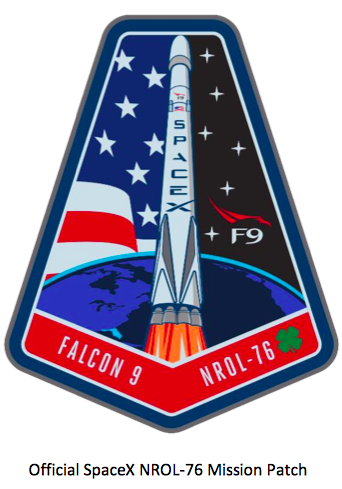
SpaceX is targeting launch of NROL-76 from historic Launch Complex 39A (LC-39A) at NASA’s Kennedy Space Center in Florida. The two hour launch window opens on Sunday, April 30, at 7:00 a.m. EDT, or 11:00 UTC. A backup launch window opens on Monday, May 1, at 7:00 a.m. EDT, or 11:00 UTC.
Following stage separation, Falcon 9’s first stage will attempt to land at SpaceX’s Landing Zone 1 (LZ-1) at Cape Canaveral Air Force Station, Florida.
Launch Vehicle
Official SpaceX NROL-76 Mission Patch
NROL-76 will launch on Falcon 9, a two-stage rocket designed from the ground up by SpaceX for the reliable and cost-efficient transport of satellites and SpaceX’s Dragon spacecraft. As the first rocket completely developed in the 21st century, Falcon 9 was designed from the beginning for maximum reliability. Falcon 9’s simple two-stage configuration minimizes the number of separation events – and with nine first stage engines, it can safely complete its mission even in the event of an engine shutdown.
Launch Facility
Launch Complex 39A at Kennedy Space Center, Florida
Launch Complex 39A (LC-39A) at NASA’s Kennedy Space Center has a long and storied history dating back to the early 1960s. Originally built to support the Apollo program, LC-39A supported the first Saturn V launch (Apollo 4), and many subsequent Apollo missions, including Apollo 11 in July 1969. Beginning in the late 1970s, LC-39A was modified to support Space Shuttle launches, hosting the first and last shuttle missions to orbit in 1981 and 2011 respectively.
In 2014, SpaceX signed a 20-year lease with NASA for the use of historic Launch Complex 39A. Since then, the company has made significant upgrades to modernize the pad’s structures and ground systems, while also preserving its important heritage. Extensive modifications to LC-39A have been made to support launches of both commercial and crew missions on SpaceX’s Falcon 9 and Falcon Heavy launch vehicles.
SpaceX.com April 2017
Mission Timeline (all times approximate) COUNTDOWN
Hour/Min/Sec
- 01:13:00 - 01:10:00 - 00:45:00 - 00:07:00 - 00:02:00 - 00:01:30 - 00:01:00 - 00:01:00 - 00:00:03 - 00:00:00
LAUNCH AND LANDING
Hour/Min/Sec Events
00:01:08 00:02:17 00:02:20 00:02:28 00:02:48 00:07:09 00:08:46
Resources
Events
Launch Conductor takes launch readiness poll
RP-1 (rocket grade kerosene) loading underway
LOX (liquid oxygen) loading underway
Falcon 9 begins engine chill prior to launch
Range Control Officer (USAF) verifies range is go for 1st stage return SpaceX Launch Director verifies go for launch
Flight computer commanded to begin final prelaunch checks Propellant tank pressurization to flight pressure begins
Engine controller commands engine ignition sequence to start Falcon 9 liftoff
Max Q (moment of peak mechanical stress on the rocket) 1st stage engine shutdown/main engine cutoff (MECO) 1st and 2nd stages separate
Second stage engine starts
Fairing deploy
1st stage entry burn begins 1st stage landing
Quelle: SpaceX
+++
Update: 13.10 MESZ:
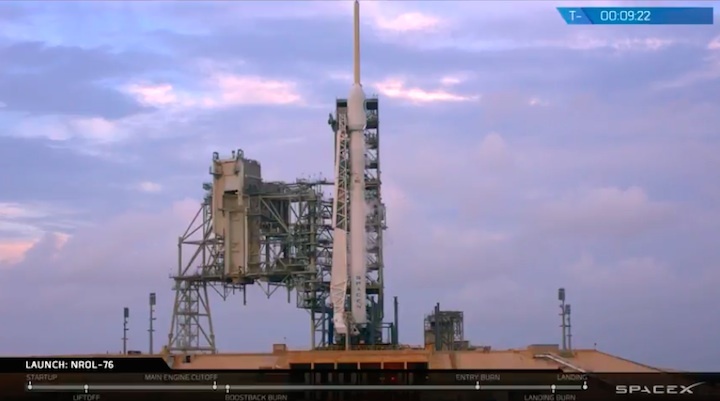
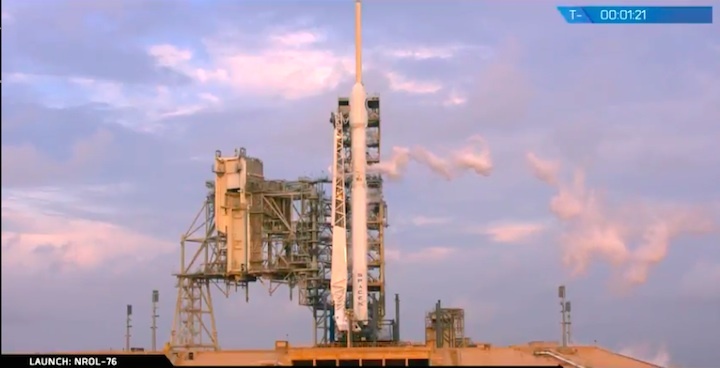


+++
Update: 17.00 MESZ
.
SpaceX spy launch scrubbed Sunday, rescheduled for Monday

WASHINGTON – The launch of a spy satellite aboard a SpaceX Falcon 9 was postponed for 24 hours Sunday morning after the launch company detected an issue with a sensor on the rocket’s first stage less than a minute before the scheduled liftoff.

Just 52 seconds before liftoff was set to occur, SpaceX called a 24-hour hold to check out the sensor, pushing the launch to Monday’s two-hour backup window that opens at 7 a.m. Eastern.
“Standing down today due to a sensor issue; backup launch opportunity tomorrow morning,” SpaceX posted to Twitter.

The classified payload for the mission designated NROL-76 is a satellite for the National Reconnaissance Office, SpaceX’s first mission for the spy agency. It is also the first launch since successfully launching and landing a previously-flown Falcon 9 booster March 30 on a mission for commercial satellite operator SES.
The rocket will lift off from SpaceX’s Launch Complex 39A at Kennedy Space Center, Florida. Should the launch occur as planned Monday, the company will attempt to recover the first stage booster, landing it at Landing Zone 1 at Cape Canaveral Air Force Station.
Quelle: SN
---
Update: 1.05.2017 / 7.35 MESZ
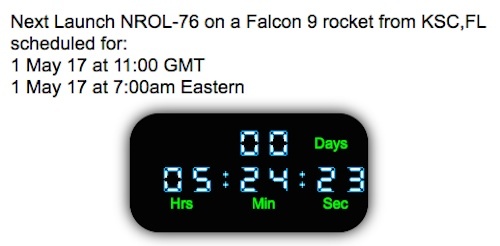
+++
Update: 2.05.2017
.
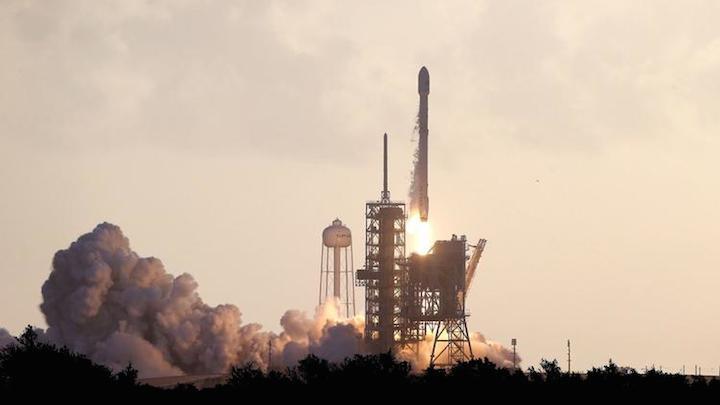
SpaceX just launched a mysterious spy satellite toward orbit for a U.S. intelligence agency.
Elon Musk's commercial rocket company made a successful liftoff Monday morning from Kennedy Space Center at Cape Canaveral, Florida.
The mission was supposed to happen Sunday, but SpaceX delayed its flight because of a sensor problem on the bottom part of the rocket.
The customer for the launch was the National Reconnaissance Office, a U.S. government agency that develops and maintains spy satellites.
The payload, referred to as NROL-76, is classified. SpaceX shared no details on what type of surveillance the device will perform, how large it is or where in orbit it's being delivered.
The NRO says it surveys potential threats to the United States by tracking terrorists and monitoring the development of nuclear weapons in other countries. It can also provide an early warning of a potential missile strike.
SpaceX typically broadcasts entire missions online, but this time the company shut off footage of the launch just after the first-stage booster separated from the upper stage of the rocket.
SpaceX also achieved one of its defining endeavors: landing the rocket safely back on Earth.
About seven minutes after liftoff, the first-stage rocket booster separated from the upper stage and fired up its engines again so it could safely cut back through the Earth's atmosphere. An on-board computer then guided the rocket to a pinpoint landing on a 300-foot platform back at Kennedy Space Center.
The maneuver is done by no other rocket launcher. Rockets are typically discarded after a mission.
It's all part of the company's mission to drastically reduce the cost of space travel by using rockets more than once. Last month, SpaceX made huge strides toward that feat by putting a used rocket back into action.
The rocket used Monday was new. Its successful landing back on Earth marked the 10th time SpaceX has recovered one of its rockets.
The company says some of those will be put to use later this year. It's planning as many as six more missions with used rockets in 2017.
Quelle: CNN


